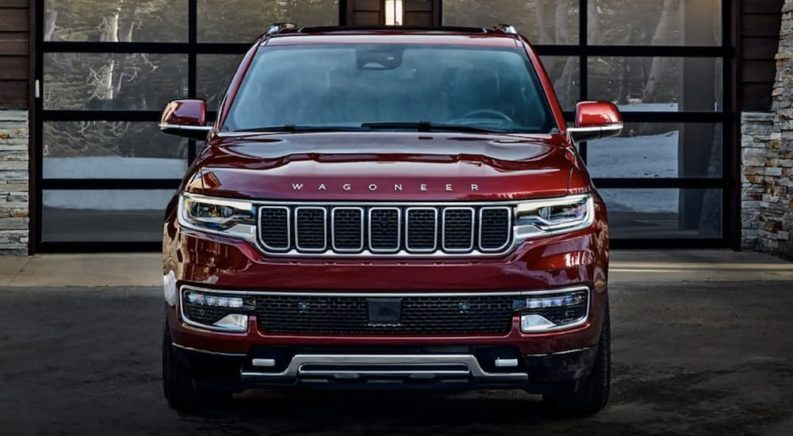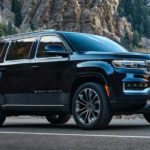There aren’t many nameplates with the sort of divergent history that the Wagoneer has. What do I mean by that? Well, if you go back and look at the early generations of the Wagoneer from the early 1960s up through the late 1980s, it’s a completely different beast from the current remastered, remade, and rejuvenated nameplate that is synonymous with full-size luxury. What you’ll find now at a Wagoneer dealership is not entirely far removed from what you used to find, but it’s definitely a departure from the casual wood-grain panels on the side and the boxy frame that screamed “middle-America family vehicle.”
No, today’s Wagoneer is a slightly different machine. It’s designed from a whole new stock and trade of parts and performance philosophy. However, there are still some connections that remain between the nameplate’s opposite-ended personality from where it started to where it is today. Namely, the spirit of the Wagoneer is still the same: a vehicle you can pack the entire family into and rely on to tackle on-road and off-road activities alike. There’s still the fundamental utilitarian aspect that the Wagoneer embodies, which has echoed throughout its original run and even to its latest comeback as a more refined, upscale SUV.
Catering to a Neglected Market
The original Wagoneer had a distinct attack vector: cater to the segment of the market that had been neglected. While this could pretty much explain every niche vehicle that was made to fulfill something that some segment of the market desired but wasn’t being given by automakers, the original Wagoneer was specifically targeting a specific group: families looking for a full-size vehicle that could actually handle not only day-to-day errands, but also vacations, camping trips, cross-country hauls, and off-road activities.
It wasn’t trying to be a Wrangler or some sort of adventure vehicle, but it was the kind of vehicle that could get you to a destination full of adventures. It was the weekend warrior vehicle…for families. And the reality of the situation is that from the 1960s up through the 1980s, it served its purpose well, and the manufacturer(s) were handsomely rewarded for the effort. A lot of this was owed to the Wagoneer’s future-proof design.
A Future-Proof Design Philosophy
The original Wagoneer had a lot going for it, especially since its original design only underwent very modest changes over a nearly 30-year production run. That speaks volumes about how popular, how stable, how effective, and how future-proof the Wagoneer’s original design was. The inclusion of four-wheel drive, powerful I6 and later V8 engines, and rugged durability helped give the Wagoneer a strong presence on the market.
However, what really helped separate it from the competition was the luxury-oriented, family-friendly interior. It was as rugged as it was comfortable, and that was a rare trait back during that time. High-quality interior fabrics and material, a smooth ride thanks to a forward-thinking suspension setup, four doors, and a unique exterior all helped to give the Wagoneer defining traits that you wouldn’t find in just any other vehicle at the time. All these standout features are what cemented the legacy of the Wagoneer during its initial production until it all came to an end.
Where The Wagoneer Went Wrong
For a luxury SUV that did everything right for close to 30 years, how did the Wagoneer suddenly and abruptly fall off the wagon (pun intended)? Well, it wasn’t actually the Wagoneer that went wrong, so much as it was the wrong kind of vehicle for the changing times. Lots of emission regulations, economic fluctuations, and high gas prices all helped contribute to edging the Wagoneer out of the market.
With oil prices on the rise and the Wagoneer’s fuel economy being 11 miles to the gallon, it contributed to a host of other problems that all came together to spell doom for the Wagoneer. New regulations and engineering requirements meant that the entire Wagoneer platform would require a complete overhaul from top to bottom. Essentially, the Wagoneer, as it was, was no longer welcome on the market. Instead of completely overhauling the vehicle, the losses were cut, and the Wagoneer was shelved back in 1991 after an illustrious 28-year production run.
The Wagoneer’s Big Comeback
After a three-decade hiatus––almost the amount of time that the original Wagoneer had been on the assembly line––the new Wagoneer came back bigger, better, and more efficient than ever. It may be a full-size SUV, but it now sports a slightly improved fuel economy rating of 16 miles to the gallon in the city and up to 22 miles to the gallon on the highway. The four-wheel drive capabilities are also a big part of the revival of the nameplate, utilizing some of the impressive traction and stability systems found in the Cherokee and Wrangler. All of this helps give it a modern-day edge.
An argument could be made that the Cherokee and Grand Cherokee occupy the middle-of-the-road space that the original Wagoneer nameplate occupied on the market during its run. So where does that leave the new Wagoneer and its more luxurious sibling, the Grand Wagoneer? Well, in the full-size luxury department. Lots of streamlined interior luxury elements were purposely built into the revived nameplate’s cabin, giving it what one of the designers called the look of a “sculpture.” This is where the new Wagoneer departs from the old. The new Wagoneer is all about luxury.
You can certainly see some of the influences of the old with a lot of the technology and advancements of the new. However, the entire tone of the Wagoneer’s design is now more upscale. It’s about fitting into a place in the market where it isn’t cannibalizing a segment occupied by some of its corporate siblings. It’s larger than the Wrangler and more luxurious than the Cherokee, and this is what helps define its pathway back onto the auto industry’s marketplace.
Wagoneer’s Current Target Market
Keep in mind that the Wagoneer of today is not only tonally different from the Wagoneer of yesteryears, but it serves a completely different market. Back when the original hit a local Wagoneer dealership, the concept of an SUV was foreign to most people, and it filled a sports-family utility role in between a station wagon and a truck. However, today, nearly every company has a vehicle like that.
You can’t throw a stone without hitting a subcompact, compact, midsize, or full-size SUV. So simply bringing the Wagoneer back as yet another all-wheel drive, slightly rugged, fairly large SUV would be pointless. That’s why the decision to target a different market makes sense. The role that the original Wagoneer fulfilled is currently being occupied by more fitting vehicles like the Renegade, Cherokee, and Grand Cherokee. Trying to fit the Wagoneer between those slots makes no sense at all.
However, structuring the vehicle around the full-size luxury segment makes a ton of sense. It’s a thin segment occupied by only a few notable entries, such as the Escalade and the Navigator, to name a few (or the ones worth mentioning). Nudging into that space not only avoids the highly competitive compact and midsize space, but it also gives the Wagoneer a chance to shine as a different sort of luxury vehicle, one with a history of being rugged and durable––something the competition can’t quite as easily attest to. It makes for an interesting dynamic and proves that even old nameplates that have run their course can find new life with a little spirited innovation and invigorated engineering.




